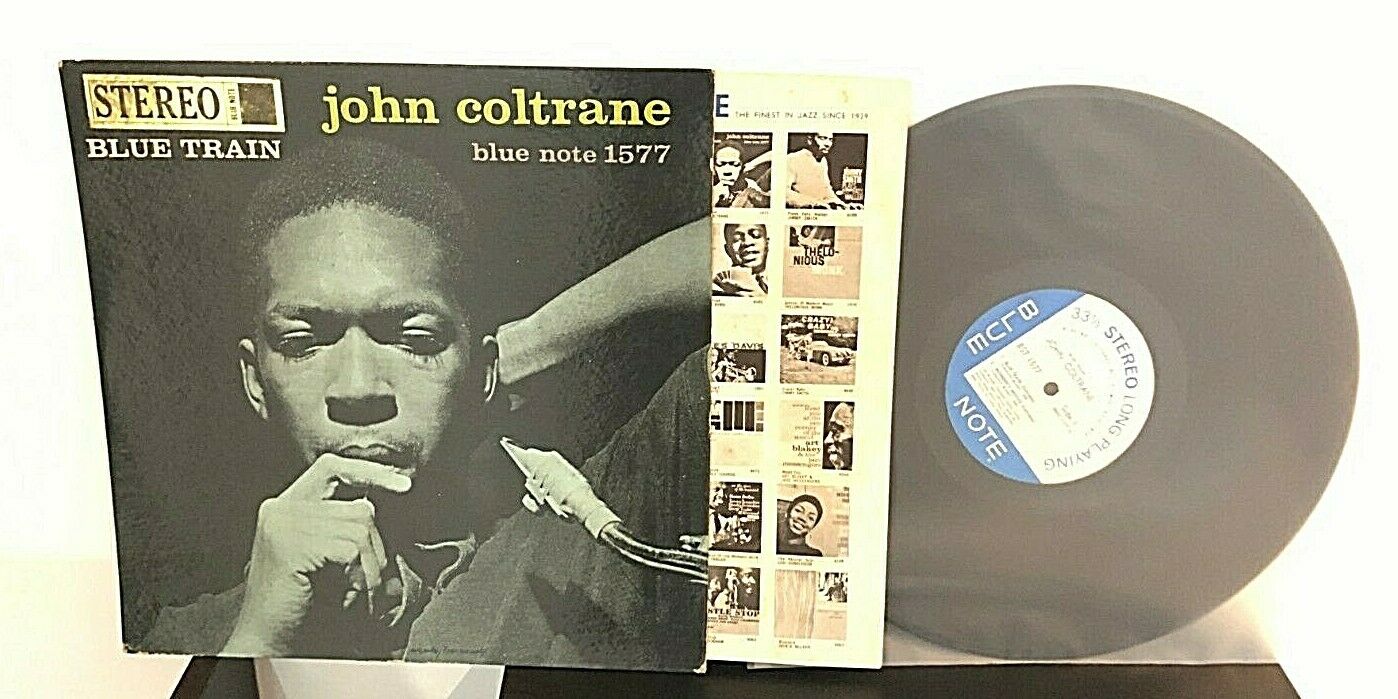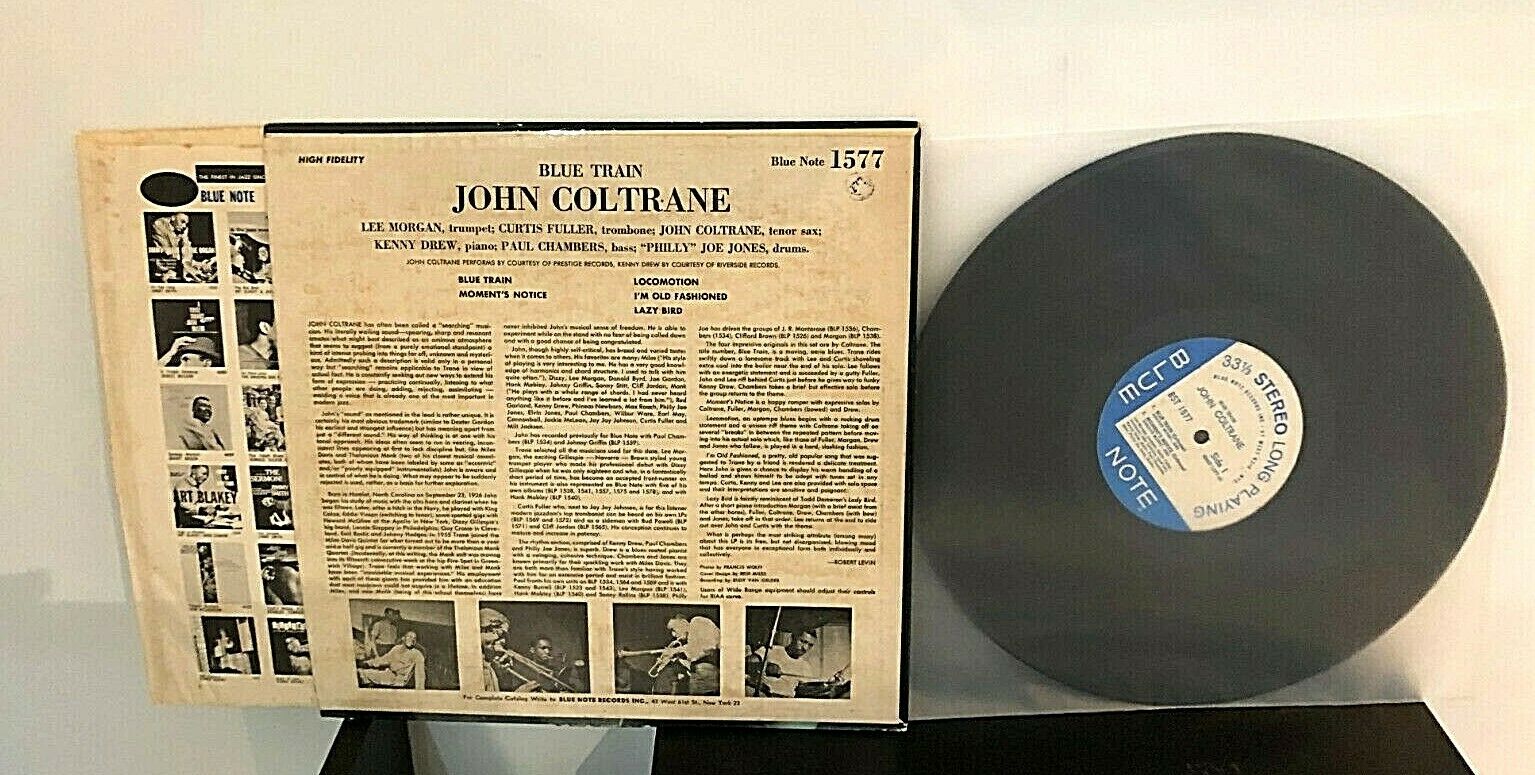JOHN COLTRANE BLUE TRAIN RECORD 1ST STEREO PRESS DG RVG 47 W 63RD BLUE NOTE EX
$
373
$ 373
Sold For
Jun 8, 2020
Sold Date
Jun 1, 2020
Start Date
19
Number Of Bids
USA
Country Of Seller
eBay
Auctioned at
Favourite Auctions
To save auctions to your favourites, please login
If you don't have an account, please register
Description
Selling off my rare rock, prog rock and jazz records - check out my other auctions! All auctions start at $0.99
John Coltrane - Blue TrainBST 1577Original Stereo Pressing
Sleeve: VG+
Sleeve has some wear, contains original signature gold STEREO sticker
Vinyl: EX
A beautiful, shiny copy. Plays with occasional surface noise.
This is the first STEREO pressing on the Blue Note label, BST 1577. This has the Deep Groove, RVG (Rudy Van Gelder) stamp, Plastylite Ear on both sides, and 47 W 63rd Labels.
----
The album was recorded in the midst of Coltrane's residency at the Five Spot as a member of the Thelonious Monk quartet. The personnel include Coltrane's Miles Davis bandmates, Paul Chambers on bass and Philly Joe Jones on drums, both of whom had worked before with pianist Kenny Drew. Both trumpeter Lee Morgan and trombonist Curtis Fuller were up-and-coming jazz musicians, and both would be members of Art Blakey's Jazz Messengers, working together on several of Blakey's albums.
All of the compositions were written by Coltrane, with the exception of the standard "I'm Old Fashioned". The title track is a long, rhythmically variegated blues with a sentimental [quasi minor; in fact based on major chords with flat tenth, or raised ninth] theme that gradually shows the major key during Coltrane's first chorus. "Locomotion" is also a blues riff tune, in forty-four-bar form. During a 1960 interview, Coltrane described Blue Train as his favorite album of his own up to that point.
Although never formally signed, an oral agreement between John Coltrane and Blue Note Records founder Alfred Lion was indeed honored on Blue Train -- Coltrane's only collection of sides as a principal artist for the venerable label. The disc is packed solid with sonic evidence of Coltrane's innate leadership abilities. He not only addresses the tunes at hand, but also simultaneously reinvents himself as a multifaceted interpreter of both hard bop as well as sensitive balladry -- touching upon all forms in between. The personnel on Blue Train is arguably as impressive as what they're playing. Joining Coltrane (tenor sax) are Lee Morgan (trumpet), Curtis Fuller (trombone), Kenny Drew (piano), Paul Chambers (bass), and Philly Joe Jones (drums). The triple horn arrangements incorporate an additional sonic density that remains a trademark unique to both this band and album. Of particular note is Fuller's even-toned trombone, which bops throughout the title track as well as the frenetic "Moments Notice." Other solos include Paul Chambers' subtly understated riffs on "Blue Train" as well as the high energy and impact from contributions by Lee Morgan and Kenny Drew during "Locomotion." The track likewise features some brief but vital contributions from Philly Joe Jones -- whose efforts throughout the record stand among his personal best. Of the five sides that comprise the original Blue Train, the Jerome Kern/Johnny Mercer ballad "I'm Old Fashioned" is the only standard; in terms of unadulterated sentiment, this version is arguably untouchable. Fuller's rich tones and Drew's tastefully executed solos cleanly wrap around Jones' steadily languid rhythms. Without reservation, Blue Train can easily be considered in and among the most important and influential entries not only of John Coltrane's career, but of the entire genre of jazz music as well.
Maybe it’s the blueness of the cover, or its chamber-like sound, but John Coltrane’s Blue Train, like Miles Davis’s Kind of Blue, frequently puts listeners in a reflective mood.
The cover photo of Blue Train, Coltrane’s second album as a leader and the only recording he made for Blue Note, shows the saxophonist seemingly deep in thought, his face, arms and shoulders, and the mouthpiece of his instrument, saturated in a blue chiaroscuro. It’s a profound album cover, probably one of the greatest ever printed.
The session found Coltrane at an important juncture in his career. About four months earlier, he had quit using heroin, and at the time of Blue Train’s recording, he was performing regularly at the Five Spot in New York in Thelonious Monk’s quartet. It’s probably safe to assume that his newfound sobriety, coupled with the influence of Monk’s awkwardly refined sense of harmony, gave Coltrane a lot to think about.
On Blue Train, Coltrane is in very good company. To start, there are his two old bandmates from the Miles Davis Quintet, drummer Philly Joe Jones and bassist Paul Chambers. (Davis had kicked Coltrane out of his group about five months prior to this recording.) Pianist Kenny Drew fills out the rhythm section, while trumpeter Lee Morgan and trombonist Curtis Fuller (the only player from this session who’s still alive) complete the front line.
The title track, a haunting 10-minute blues, establishes Coltrane as one of the great interpreters of the form in jazz. In its starkness, it feels like a nod to the modal music Coltrane would later play, most notably on the 1961 album My Favorite Things. Still, Coltrane solos with lots of notes, using long tones and uneven phrases—and he sounds restless, as though he is trying to keep hold of all the ideas sloshing around in his mind. Morgan enters after Coltrane, with a spare and memorable opener. (He was very good at those. Listen to his solo on the title track of Art Blakey’s Moanin’, a Blue Note release recorded a year later, for another instance.)
On “Locomotion,” the album’s third track, Morgan explodes like a firecracker into a suspenseful, eight-bar break. His ensuing solo is an intricate braid of sound; his phrases never tangle. (Such virtuosity prompted the critic A.B. Spellman to describe Morgan’s performance as “one of the great jazz trumpet solos.”) The trumpeter’s brassy articulation serves as a good foil to Fuller’s smooth, soft-toned lyricism on trombone.
“Moment’s Notice,” another Coltrane original with fast-moving chord changes, presages the recording of “Giant Steps”—Coltrane’s impossibly methodical composition that now exists almost solely for pedagogical purposes—by about two years. “Lazy Bird,” too, which supposedly draws from Tadd Dameron’s “Lady Bird” (which, in turn, draws from the standard “Have You Met Miss Jones?”) is another bellwether of Coltrane’s intensely focused attention to harmony.
And then there is the ballad “I’m Old Fashioned,” the only track on the album that Coltrane didn’t write. It is simply lovely. Coltrane could play very sweetly when he wanted to, and this song marks the musician as a refined and sensitive ballad player—one of the best in jazz.
To call Blue Train a hard bop album, as many have done, sort of misses the point of Coltrane’s singular, and expansive, vision. Coltrane was not a hard bop musician, just like his then-boss, Thelonious Monk, cannot be described as a bebop musician, although he recorded with Charlie Parker, Max Roach and Dizzy Gillespie, among others. If you want to try to understand Coltrane, it helps to look atBlue Train almost as a living thing, a signpost indicating some of the many roads he would explore in the 10 years before his early death. But it also exists just fine on its own.
Grading System:
MINT - Only an unplayed or sealed record gets this gradeNM (Near Mint) - Shows very little sign of play with very minimal or no scratchesEX (Excellent) - Close to near mint, but with more than one or two small scratches that do not impact playVG+ (Very Good+) - Only has hairline scratches that are not obtrusive, may play with some surface noise at partsVG (Very Good) - Has multiple hairline scratches of varying sizes, possibly a feel-able scratch that would impact play if notedG+ (Good plus) - Has many scratches, including feelable ones that impact playG (Good) - Never understood why this is called "good", a record with this grade is far from it. Many feelable scratches, possibly a skipP (Poor) - I typically do not auction records in this condition
Shipping:
US Shipping via Media Mail: $6.00 ($1 each additional record)Shipping to Canada via Canada Post (no customs fees): $13 ($2 each additional record)Worldwide shipping (untracked/uninsured): $19 ($5 each additional record)Worldwide shipping (tracked/insured): $27 ($7 each additional record)
Combined shipping is available.
price rating

